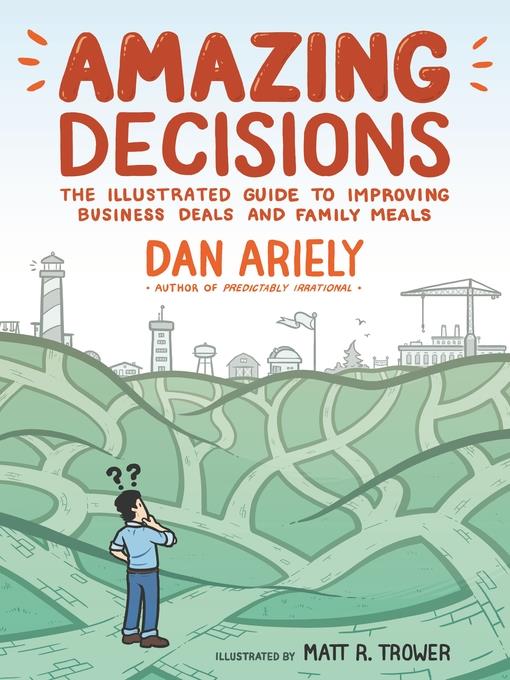
Amazing Decisions
The Illustrated Guide to Improving Business Deals and Family Meals
کتاب های مرتبط
- اطلاعات
- نقد و بررسی
- دیدگاه کاربران
نقد و بررسی

May 6, 2019
The fraught process of decision making is given a jaunty exploration in this perkily drawn graphic handbook. Behavioral economist Ariely (Predictably Irrational) presents his theories through the characters of energetic scientist Dana and befuddled Adam, who thinks he has to choose between two sets of norms. One is represented by the market fairy (who flits around in a suit and tosses off statements like “We thrive through competition and the free market”) and the other by the social fairy (“You completely missed the point of a social exchange!”). In basic drawings, Adam is walked through the balancing of social and market forces required to negotiate the tricky territories of friendship, families, and gift giving (hint: don’t offer to pay your mother for Thanksgiving dinner, no matter what the market fairy says). Thereafter, Dana overviews social science experiments, which have shown how people react to motivation in complicated and nonintuitive ways. For instance, subjects in one test worked less hard on a routine computer problem when offered money than those offered nothing. In another example, simple social reminders incentivized better than punishments. This easy-reading guide is a useful addition to the pop social-science canon, likely to get clipped for slideshow presentations from classrooms to boardrooms. Agent: James Levine, Levine Greenberg

May 15, 2019
Ariely (Psychology and Behavioral Economics/Duke Univ.; Payoff: The Hidden Logic That Shapes Our Motivations, 2016, etc.) and illustrator Trower break ranks to show that money isn't everything. There are social norms, and there are market norms. The two do not always coincide: People do things in the market for financial reasons, but they do things in the social sphere out of love, loyalty, desire, and other nonmonetary considerations. According to the author, deciding which norm to put to work is the basis of good decision-making. In an early example in this engagingly illustrated graphic tour, Ariely depicts a character who decides that it's only right to reward his in-laws with cash in return for their having cooked him a fantastic Thanksgiving dinner. Such a person would rightly be thought a clod even though he would err in the other direction by leaving a restaurant without paying. Situational thinking, then, is in order, and as Ariely's "social fairy" alerts the poor guy, "you completely missed the point of a social exchange." Ariely provides a number of other examples, based on economic research, showing that people are not always motivated by money, even in the marketplace. A simple cash bonus often does not prompt better productivity, while a meaning-laden, human expression of appreciation goes a long way. Ariely counsels that thinking about where values and rewards align is the proper way to arrive at decisions about how to motivate workers, how to encourage charitable donations and voting, and other such things. As he writes, winningly, "we can strategically use social norms or market norms to encourage people to act in the best interests of themselves, those around them, and their world as a whole." As is usual with Ariely, the dismal science is rendered anything but dismal with the use of provocative real-world examples of how people actually do things outside of the textbooks.
COPYRIGHT(2019) Kirkus Reviews, ALL RIGHTS RESERVED.

August 2, 2019
Ariely (James B. Duke Professor of Psychology and Behavioral Economics, Univ.; Predictably Irrational; The (Honest) Truth About Dishonesty) teams with Trower (resident artist, Ctr. for Advanced Hindsight, Duke Univ.) to produce a straightforward, accessible guide to decision-making. The slight narrative centers on Adam, who is clueless about his daily interactions with friends and family. From a lab coat-garbed companion, Adam receives advice about his encounters with others that involves negotiating market and social values. In classic cartoon style, the "market fairy" and "social fairy" voice these points of view. Ariely shows how our social life, including gift giving, differs from a pure market analysis, and how business and the workplace are improved by nonmarket considerations and interpersonal relationships. The work then moves from individuals to discuss how solutions to social issues can be influenced by concepts about decision-making. Integrated throughout are behavioral studies explained with full citations. Trower's uncluttered art effectively complements Ariely's analysis, enlivening the text with humor. VERDICT This clear volume makes Ariely's ideas accessible to a wide audience interested in decision-making in either a personal or business context. [Previewed in Ingrid Bohnenkamp's "Mass Appeal," LJ 6/19.]--Bill Hardesty, Georgia State Univ. Libs., Atlanta
Copyright 2019 Library Journal, LLC Used with permission.

July 1, 2019
In this graphic guide to decision-making, Ariely provides his psychological and economic expertise to detail the differences between market norms and social norms and how to apply them to one's personal and professional lives. The advice is given in the style of a 1950s educational film, and the reader follows Adam, the student, and Dana, whose goal is to help people make better decisions. Adam is having difficulty differentiating between the norms, so Dana, along with a market fairy and a social fairy (think of the devil and angel sitting on the shoulders of someone trying to make a choice), provides lessons. Comprehensive and complete with relatable, detailed studies, this volume offers readers easy-to-understand concepts, regardless of their level of economic knowledge. Trower's black-and-white illustrations are no-frills, making the text the focus of the book. He seems to represent a wide range of cultures in his depiction of people. Recommend this conversational primer to fans of the Freakonomics books and podcast; it may even serve as a gateway into the world of graphic novels.(Reprinted with permission of Booklist, copyright 2019, American Library Association.)

























دیدگاه کاربران